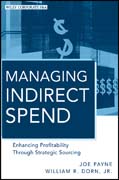
Managing indirect spend: enhancing profitability through strategic sourcing
Payne, Joe
Dorn, William R.
Unique guidance for cutting costs regardless of economic conditions--without reducing headcounts Successfully reduce costs in the area of indirect spend and watch your bottom line grow. Managing Indirect Spend provides you with the knowledge and tools necessary to get it done with an overview of: the challenges faced when sourcing indirect spend categories; strategic sourcing process; tools that can help drive savings, and examples based on real world experience.This how-to guide clearly covers specific sourcing engagements and provides the details needed to source effectively. Includes sections covering the process, the tools, real-world examples, guidance through specific sourcing engagements and the information needed to source effectively Presents guidance for achieving the object of strategic sourcing: cost reduction Shows how effectively managing indirect costs can provide a huge impact on bottom line growth Coversall areas of Market Intelligence (MI) With tools, real world examples, and workable guidance, Managing Indirect Spend provides insider guidance for big bottom-line growth through effective management of indirect costs. INDICE: Preface. Acknowledgments. Introduction: What is Indirect Spend, and How Does One Manage It? Part 1: The Process. Chapter 1: An Introduction to Strategic Sourcing (Joseph Payne). Chapter 2: Data Collection and Analysis (Joseph Payne). Chapter 3: Conducting Research (Joseph Payne). Chapter 4: The RFx Process (Kathleen Daly). Chapter 5: Scorecarding Suppliers (Kathleen Daly). Chapter 6: Negotiations (Joseph Payne). Chapter 7: Get It in Writing: The Contracting Phase (Joseph Payne). Chapter 8: Implementation and Continuous Improvement (Joseph Payne). Chapter 9: What Not to Do during a Strategic Sourcing Initiative (William Dorn). Part 2: The Tools. Chapter 10: The Importance of Market Intelligence (William Dorn). Chapter 11: Tools to Assist You in Gathering Dataand Expediting the Sourcing Process (William Dorn). Chapter 12: Increasing Stakeholder Engagement (Dave Pastore). Part 3: Examples from the Field. Chapter 13: Supplier Collaboration (William Dorn). Chapter 14: Leveraging Supplier Feedback (William Dorn). Chapter 15: Data Analysis: Transforming Data into Information (Dave Pastore). Part 4: How to Do It. Chapter 16: Office Supplies and the Sourcing Process (Jen Ulrich). Chapter 17: Negotiating Local and Long Distance (Dave Pastore). Chapter 18: How Cellphone Management Drives Continuous CostSavings (William Dorn). Chapter 19: How Cellphone Management Drives Continuous Cost Savings (William Dorn). Chapter 20: Making Sense of MRO Spend (KathleenDaly). Chapter 21; Analyzing Shipping Costs (Joseph Payne). Chapter 22: Sourcing Services (Jen Ulrich and Scott Decker). About the Authors. About the Contributors. Index.
- ISBN: 978-0-470-88688-5
- Editorial: John Wiley & Sons
- Encuadernacion: Cartoné
- Páginas: 464
- Fecha Publicación: 19/10/2011
- Nº Volúmenes: 1
- Idioma: Inglés
